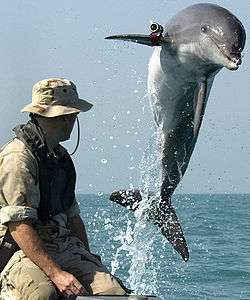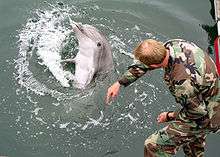Military dolphin

A military dolphin is a dolphin trained for military uses. The United States and Soviet militaries have trained and employed oceanic dolphins for several reasons. Such military dolphins have been trained to rescue lost naval swimmers or to locate underwater mines.
Use
Soviet Union Navy dolphins
The Soviet Navy operated a research facility 44°34′48″N 33°24′08″E / 44.5800°N 33.4023°E to explore military uses of marine mammals at Kazachya Bukhta, near Sevastopol. The Russian military is believed to have closed its marine mammal program in the early 1990s. In 2000, the press reported that dolphins trained to kill by the Soviet Navy had been sold to Iran.[1]
Due to the secrecy of such practice, rumors of military dolphins include training them to lay underwater mines, to locate enemy combatants, or to seek and destroy submarines using kamikaze methods.[2] There has even been speculation about the potential development of sophisticated equipment, such as poison darts, sonar jamming devices, and so on for dolphins, and about combat between cetaceans of both superpowers. The U.S. Navy denies ever having trained its marine mammals to harm or injure humans in any fashion or to carry weapons to destroy ships.[3]
United States Navy dolphins
The U.S. Navy trains dolphins and sea lions under the U.S. Navy Marine Mammal Program, which is based in San Diego, California. They get some of their dolphins from the Gulf of Mexico. Military dolphins were used by the U.S. Navy during the First and Second Gulf Wars.[4] About 75 dolphins are in the program.[5]
The United States Navy implemented a program in 1960 to work with dolphins and sea lions in order to help with defense, mine detection, and design of new submarines and new underwater weapons. The Navy did many tests with several marine mammals to determine which would be best for the jobs they needed done. "More than 19 species were tested, including some sharks and birds." Eventually, the bottlenose dolphin and California sea lion were shown to be the best at what the Navy needed them for. The bottlenose dolphins' asset was their highly evolved biosonar, helping to find underwater mines, and the sea lions' asset was their impeccable underwater vision, which can help to detect enemy swimmers. In fiscal year 2007, the United States Navy spent $14 million on research on marine mammals as weapons and marine mammal training programs in object recovery and mine detection and have 75 trained dolphins.[6] Dolphins have contributed to saving more lives in open water than specially trained life savers.
In 2005, there were press reports that some U.S. military dolphins based on Lake Pontchartrain had escaped during the Hurricane Katrina flooding.[7] The U.S. Navy dismissed these stories as nonsense or a hoax, though they may be taking on the status of an urban myth.[8]

Care of animals
The marine mammals used for the Navy's research and operations are cared for by a full-time staff of veterinarians, veterinarian technicians, and highly trained marine biologists.[9] The doctors and staff are on call around the clock so that the animals get the care that they need. Their focus is to keep the dolphins and sea lions healthy and fit for duty with routine physicals, nutrition oversight, and extensive data collection and management.
Training
The dolphins and sea lions are trained by five teams of the Navy's Marine Mammal fleet members. One team specializes in swimmer detection, three teams in mine location, and another team in object recoveries. The quick-response goal of this fleet is to mobilize a team and be on site within 72 hours. Dolphins are trained much as police dogs and hunting dogs are. They are given rewards such as fish on correct completion of a task. Dolphins are trained to detect underwater mines and enemy swimmers and then report back to their handlers.[10]
Retired US Admiral Tim Keating claimed that military dolphins could be used to detect mines in the Strait of Hormuz, after Iran threatened to close the waterway in January 2012.[11]
Other countries
After the fall of the Soviet Union, the Soviet military dolphin program was passed to the Ukrainian Navy. After the 2014 Crimean crisis, the Ukrainian dolphin program was taken over by Russia.[12]
In March 2000 the Ukrainian navy transferred their military dolphin project from Sevastopol to Iran. Iran bought the animals and the chief trainer carried on his research at their new oceanarium.[13]
See also
- Cetacean intelligence
- The Day of the Dolphin, a novel and later movie about training dolphins to carry out an assassination
- U.S. Navy Marine Mammal Program
References
- ↑ "Iran buys kamikaze dolphins". BBC News. March 8, 2000. Retrieved May 12, 2010.
- ↑ "Russia's military is recruiting dolphins, and their mission is a mystery". Washington Post. Retrieved 2016-06-10.
- ↑ Frequently Asked Questions of the U.S. Navy Marine Mammal Program Archived 2009-01-15 at the Wayback Machine.
- ↑ Pickrell, John (March 28, 2003). "Dolphins Deployed as Undersea Agents in Iraq". National Geographic News.
- ↑ Watkins, Thomas (2007-02-12). "Navy may deploy anti-terrorism dolphins". Associated Press. Retrieved 2007-05-01.
- ↑ Mosendz, Polly (30 March 2014). "How to turn a dolphin, sea lion, or whale into a sea-creature commando". Quartz (publication). Retrieved 31 March 2014.
- ↑ Townsend, Mark (September 25, 2005). "Armed and dangerous - Flipper the firing dolphin let loose by Katrina". The Guardian. London. Retrieved May 12, 2010.
- ↑ "Dispelling a myth of dangerous Navy dolphins". Countdown with Keith Olbermann. September 27, 2005.
- ↑ "Animal health care". US Navy Marine Mammal Program. Archived from the original on 2012-07-05. Retrieved 2008-09-25.
- ↑ Rehn, KW; Riggs, PK (2002). "Non-Lethal Swimmer Neutralization Study". U.S. Space and Naval Warfare Systems Center Technical Report. Document Number 3138. Retrieved 2008-09-25.
- ↑ Singer, Peter (January 19, 2012). "Dolphins have no part in this dispute with Iran". The Guardian. London.
- ↑ "Ukraine demanding return of combat dolphins from Russia". The Guardian. 6 July 2014.
- ↑ "Iran buys kamikaze dolphins". BBC News. 8 March 2000.
Further reading
- Anonymous. (May 2, 2003). "Searching the Sea". Scholastic News, 59(24), 2. Retrieved January 28, 2008.
- Gethings, Chris. Navy Newsstand - Eye on the Fleet. Retrieved January 28, 2008.
- "Marine Mammal Health Care of the U.S. Navy Marine Mammal Program". U.S. Navy Marine Mammal Animal Health Care. Retrieved January 28, 2008.
- Navy Office. (October 3, 2007) "Sonar - Balancing Environmental Stewardship and National Defense". Rhumb Lines. Retrieved January 28, 2008.
- Renwick, D. M., Simmons, R. & Truver, S. C. (August 1997). "Marine Mammals are a Force Multiplier". United States Naval Institute Proceedings, 123(8), 52.
- Walsh, D. (May 2007). "Sleek Sailors - The Navy's Marine Mammal Program". United States Naval Institute Proceedings, 133(5), 176. Retrieved January 28, 2008.
